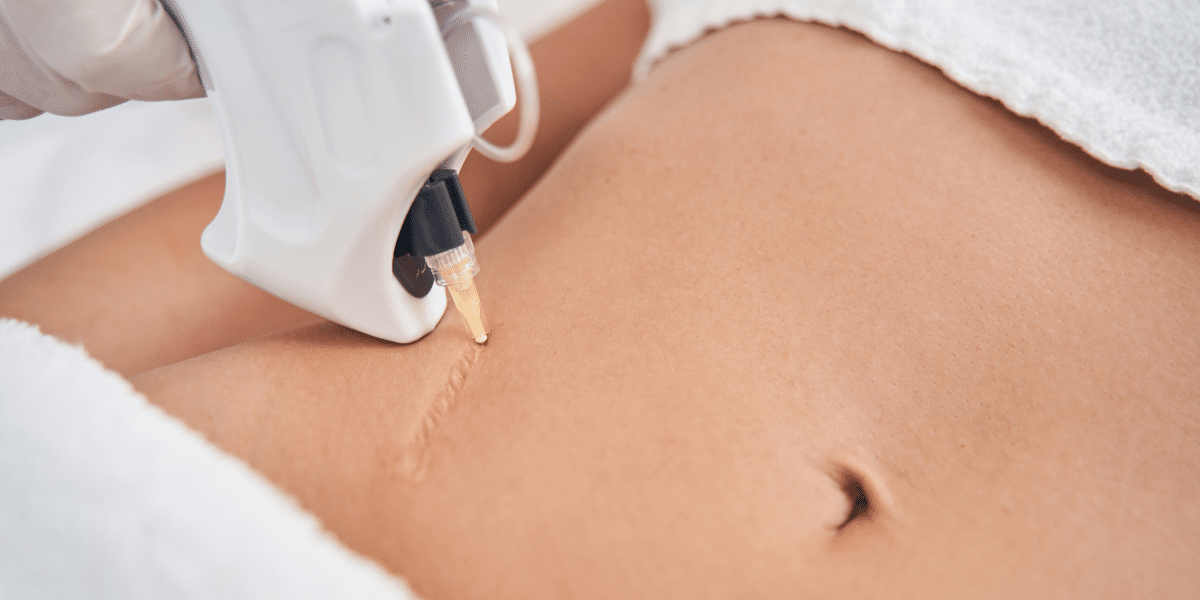Surgical scars are a natural outcome of healing after a medical procedure. While scars cannot be fully erased, advances in treatments have made it possible to significantly improve their appearance. From laser therapies to medical-grade skincare and Kenalog injections, understanding your options can help you achieve smoother, less noticeable scars. Here’s an overview of how scars form and the most effective methods for minimizing their impact.
How Do Scars Form?
Scars develop as part of the body’s healing process. When the skin is injured, it undergoes three key stages to repair itself:
- Inflammatory Phase: The body stops bleeding by forming a clot, which also acts as a scaffold for new tissue. Immune cells help clear out bacteria and dead cells.
- Proliferative Phase: New blood vessels form, and fibroblasts deposit collagen to strengthen the healing area.
- Remodeling Phase: The initial soft collagen (type III) is replaced with stronger collagen (type I), resulting in scar tissue.
This process ensures the wound heals but often leaves scars with a different texture and appearance than normal skin.
Types of Scars
Different scars require unique treatments:
- Hypertrophic Scars: Thick, red scars within the wound boundary that may fade over time.
- Keloid Scars: Raised scars that extend beyond the original wound and typically don’t fade naturally.
- Atrophic Scars: Depressed or sunken scars, often from acne or tissue loss, that respond well to resurfacing treatments.
Advanced Treatments for Surgical Scars
1. Laser Therapy
Laser therapy can be a helpful option for improving the appearance of scars. By using concentrated light energy, lasers stimulate collagen remodeling and smooth out uneven skin.
- Fractional CO2 Lasers: Ideal for thick scars, creating micro-channels to boost collagen production. Suited for lighter skin tones due to hyperpigmentation risks for darker skin.
- Pulsed Dye Lasers (PDL): Helpful for reducing redness and flattening hypertrophic and keloid scars.
- Erbium Lasers: Best for atrophic scars, targeting deeper skin layers to remodel collagen and smooth the skin.
Patients may need 3–6 sessions, depending on individual factors. Spaced weeks apart. Redness and swelling are common after treatment but subside with proper aftercare.
2. Kenalog Injections
Kenalog (triamcinolone acetonide) is a corticosteroid injected into hypertrophic or keloid scars. It reduces inflammation, controls collagen production, and flattens raised scars. Monthly injections are often used, with potential improvements seen after 3–6 sessions.
3. Medical-Grade Skincare
Skincare products can support scar healing by soothing, hydrating, and promoting recovery. Key ingredients include:
- Silicone Gels and Sheets: The gold standard for scar treatment, reducing redness and improving texture.
- Centella Asiatica: A botanical extract that boosts collagen remodeling and calms irritation.
- Vitamin C: Enhances collagen production and lightens hyperpigmentation.
- Hyaluronic Acid: Maintains hydration, preventing dryness and tightness.
- Retinoids: Stimulate cell turnover, improving scar texture.
Consistency is crucial when using skincare products for scar management.
4. Microneedling
Microneedling involves using fine needles to create small punctures in the skin, which may help stimulate collagen production and improve the absorption of topical treatments. Multiple sessions are often needed, with gradual changes in scar appearance over time.
What to Expect During Treatments
During laser or injection treatments, a topical numbing cream ensures comfort. Sessions last 15–60 minutes, depending on the scar’s size and severity. Post-treatment care, such as avoiding sun exposure and following skincare recommendations, is essential for optimal healing.
Limitations and Risks
- Laser Therapy: Multiple sessions are needed, and older scars may respond less effectively.
- Kenalog Injections: Risks include skin thinning, hypopigmentation, and mild discomfort.
- Skincare Products: Results may take time and consistent application.
It’s vital to consult a qualified provider to determine the most suitable treatments based on your scar type, skin tone, and medical history.
Achieve Your Best Results
Advancements in scar treatment may help improve the appearance of scars. Combining professional treatments, such as laser therapy or Kenalog injections, with medical-grade skincare may improve results. For personalized care, it’s helpful to consult a specialist to create a plan suited to your needs.
Explore methods to minimize and improve the appearance of surgical scars. From advanced laser therapies to medical-grade skincare, learn options for achieving smoother, less noticeable scars. Read the complete guide: Healing Surgical Scars.
Disclaimer: This content is for informational purposes only and is not intended as medical advice, nor does it replace professional medical expertise or treatment. If you have any concerns or questions about your health, always consult with a physician or other healthcare professional.
Published by Charlie N.








